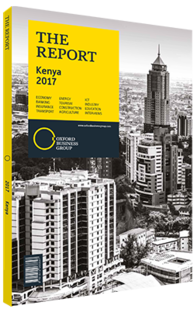Banking sector
In 2016 the Kenyan banking sector experienced varying degrees of structural and regulatory turbulence. Following the receivership of Imperial Bank and Dubai Bank in 2015, the year started off with the fall of Chase Bank, a mid-tier lender, following liquidity challenges as a result of a bank run. This led to credit tightening in the inter-bank market, with smaller banks locked out. Additionally, a large number of banking sector players continued to report reduced levels of asset book quality. Banking sector earnings in the third quarter of 2016 indicated slow profitability growth, mostly attributable to larger loss provisioning occasioned by a stricter regulatory environment in regards to non-performing asset recognition and disclosure. In the third quarter the Banking (Amendment) Act was signed into law, bringing in an era of interest rate controls. Under this regime, banking institutions are required to set their lending rates four percentage points above the central bank’s benchmark rate and pay interest earning deposits at 70% of the benchmark rate.
Following the law’s assent, the stock market experienced increased volatility from the banking sector, with the majority of stocks falling to multi-year lows, due to uncertainties regarding the effect of the interest rate controls on the banks’ profitability margins. These uncertainties still abound, but we expect more clarity on the banks’ margins from the banking results of the first half of 2017. The year ended with some activity in the mergers & acquisitions (M&A) arena. SBM Holdings of Mauritius entered the Kenyan banking arena with the acquisition of Fidelity Bank, and I&M Holdings bought out Giro Commercial Bank in June 2016.
Balance Sheet Asset Quality
As of FY16, the listed banking sector recorded an average non-performing loans (NPL) ratio of 10.86%, a multi-year high.
National Bank of Kenya, Standard Chartered Bank and NIC Bank recorded the highest ratios overall at 45.11%, 12.25% and 11.26%, respectively. The lowest ratios for the year were registered on Diamond Trust Bank (DTB), Co-operative Bank and Stanbic Bank at 3.2%, 4.3% and 5.9%, respectively.
Capital Raising
Most of the large banks are well capitalised, with a few seeking Tier-2 funding to shore up their capital ratios and increase lending capacity. There was no noted equity capital raising by the listed banking institutions at end-2016. Several banks raised Tier-2 capital. KCB Bank had earlier indicated an intention to raise KSh10bn ($97.6m) in Tier-1 capital through a rights issue to shore up its capital adequacy ratios but has since shelved these plans. To boost its Tier-2 capital position, KCB received a capital injection of KSh7.5bn ($73.2m) following talks with the International Finance Corporation in the fourth quarter of 2016.
Pricing
We see attractive pricing multiples in the banking sector. Banks are now trading at attractive price-to-book levels with the sector average settling below 1.0x book value. Our top picks include NIC Bank (P/B 0.6x) with a key driver being anticipated resolution of high NPL levels and prudent management. Stanbic at 0.8x book value with its corporate exposure set to ease Net Interest Margin erosion and support Non-Interest Revenue. KCB at 1.2x book value with management shifting focus to return on equity maximisation. Barclays at 1.1x remains an attractive dividend counter. Overall we are wary of National Bank, due to persistent management issues and close to half its loan book now in NPL territory. Also despite HF group’s seemingly discounted levels, the bank business model has a grim future with the real estate segment starting to slow down and causing upward pressure on NPL
Looking Ahead
We expect to see the stricter regulatory environment continue with respect to non-performing assets recognition, corporate governance enhancement, transparency in corporate reporting and capital requirements. Following recent developments, the banking sector has moved to defend profitability ratios through cost cutting, improvement in capacity and operational efficiencies, and through expansions.
You have reached the limit of premium articles you can view for free.
Choose from the options below to purchase print or digital editions of our Reports. You can also purchase a website subscription giving you unlimited access to all of our Reports online for 12 months.
If you have already purchased this Report or have a website subscription, please login to continue.

